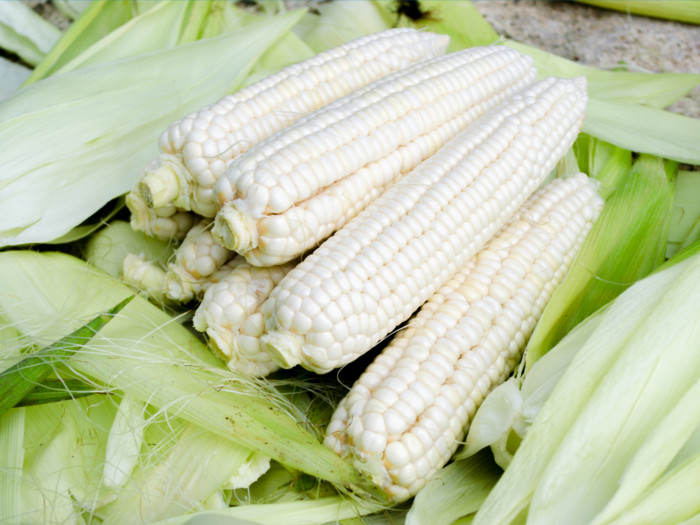Adding white corn to your diet is a great way to increase fiber intake and provides a number of other health benefits as an easy alternative to traditional corn.
What is White Corn?
White corn is a variety of sweetcorn, which is very popular in the summer months for its unique and unexpected flavor. This type of corn has about 400 kernels per ear of corn and is tightly wrapped in pale green or white leaves that form the husk. Unlike yellow corn, the window for harvesting this type of corn is slightly more narrow, as the kernels will become harder and more doughy once they pass peak ripeness. When harvested correctly, however, the kernels are succulent and sweet, perfect for a summer barbecue or a savory-sweet snack. [1]
What many people don’t know is that corn is primarily classified by the amount of starch that it contains, as this can determine what use the corn is best suited for. White corn has a relatively low level of starch, and much of it has been converted to sugar, providing the unmistakable flavor of this corn variety. Yellow corn, on the other hand, isn’t much different from white corn, although it does contain a higher level of beta-carotene, which provides the corn with its famous color. This beta-carotene means that more vitamin A is available for those who eat this colorful variety. [2]

Adding white corn to your diet is a great way to increase your fiber intake. Photo Credit: Shutterstock
| Serving Size : | |
|---|---|
| Nutrient | Value |
| Water [g] | 72.84 |
| Energy | 97 |
| Energy [kJ] | 408 |
| Protein [g] | 3.34 |
| Total lipid (fat) [g] | 1.41 |
| Ash [g] | 0.7 |
| Carbohydrate, by difference [g] | 21.71 |
| Fiber, total dietary [g] | 2.7 |
| Sugars, total including NLEA [g] | 7.73 |
| Sucrose [g] | 6.02 |
| Glucose (dextrose) [g] | 0.7 |
| Fructose [g] | 1.02 |
| Starch [g] | 4.47 |
| Calcium, Ca [mg] | 2 |
| Iron, Fe [mg] | 0.55 |
| Magnesium, Mg [mg] | 31 |
| Phosphorus, P [mg] | 92 |
| Potassium, K [mg] | 252 |
| Sodium, Na [mg] | 3 |
| Zinc, Zn [mg] | 0.54 |
| Copper, Cu [mg] | 0.06 |
| Manganese, Mn [mg] | 0.21 |
| Selenium, Se [µg] | 0.8 |
| Vitamin C, total ascorbic acid [mg] | 6.2 |
| Thiamin [mg] | 0.09 |
| Riboflavin [mg] | 0.05 |
| Niacin [mg] | 1.67 |
| Pantothenic acid [mg] | 0.75 |
| Vitamin B-6 [mg] | 0.13 |
| Folate, total [µg] | 20 |
| Folate, food [µg] | 20 |
| Folate, DFE [µg] | 20 |
| Choline, total [mg] | 29.1 |
| Carotene, beta [µg] | 1 |
| Vitamin A, IU [IU] | 2 |
| Lutein + zeaxanthin [µg] | 43 |
| Vitamin E (alpha-tocopherol) [mg] | 0.09 |
| Vitamin K (phylloquinone) [µg] | 0.4 |
| Fatty acids, total saturated [g] | 0.2 |
| 16:0 [g] | 0.19 |
| 18:0 [g] | 0.01 |
| Fatty acids, total monounsaturated [g] | 0.37 |
| 18:1 [g] | 0.37 |
| Fatty acids, total polyunsaturated [g] | 0.6 |
| 18:2 [g] | 0.59 |
| 18:3 [g] | 0.02 |
| Tryptophan [g] | 0.02 |
| Threonine [g] | 0.13 |
| Isoleucine [g] | 0.13 |
| Leucine [g] | 0.36 |
| Lysine [g] | 0.14 |
| Methionine [g] | 0.07 |
| Cystine [g] | 0.03 |
| Phenylalanine [g] | 0.16 |
| Tyrosine [g] | 0.13 |
| Valine [g] | 0.19 |
| Arginine [g] | 0.14 |
| Histidine [g] | 0.09 |
| Alanine [g] | 0.3 |
| Aspartic acid [g] | 0.25 |
| Glutamic acid [g] | 0.66 |
| Glycine [g] | 0.13 |
| Proline [g] | 0.3 |
| Serine [g] | 0.16 |
| Sources include : USDA [3] | |
Corn, both white and yellow varieties, are widely recommended in weight loss diets, as well as for lowering blood pressure, improving digestion, and improving the strength of the immune system – provided you don’t cover your ear of white corn with butter and salt!
White Corn Nutrition
The nutritional profile of white corn is somewhat surprising, as it contains about 1.5 grams of fat in a large ear of corn, but only 115 calories. However, this corn also has a very high level of dietary fiber, at 3 grams per ear, as well as a good amount of potassium, vitamin C, iron, magnesium, various B vitamins, copper, selenium, and phosphorous, among others. [4]
White Corn Uses
There are many popular ways to use white corn in our daily diet, including a very traditional way – roasting or steaming the ears of corn. At that point, spraying some olive oil and sprinkling herbs on the ear is an excellent way to enjoy it, without adding a lot of excess calories or fats. Some people prefer to shuck the corn and remove all of the kernels, which can be added to both hot and cold dishes, including vegetable salads, soups, stews, and curries. [5]
Another popular way to prepare white corn is to boil the ears of corn, as this will help to retain as much of the flavor as possible; from there, you can eat the corn raw or remove it from the ear to be used in other dishes.
